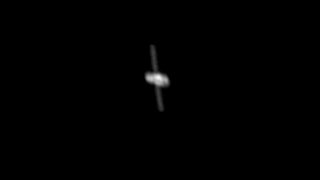Skywatcher spots Russia's Nauka science module headed to space station (photo)
Martin Lewis took the image using his home-built telescope from his home near London.

A British astrophotographer captured a stunning view of Russia's largest addition to the International Space Station yet, the Nauka science module, just hours after its launch into orbit on Wednesday (July 21).
Martin Lewis, who posts his images on the website Skyinspector.co.uk, took the photo shortly after 5 p.m. EDT (2100 GMT) from his back garden in St. Albans, some 20 miles (35 kilometers) north of London, using his home-built 222-millimeter Dobsonian telescope.
Lewis told Space.com he was preparing to image the passing International Space Station (ISS) on that day and was alerted to the pass of Nauka, also known as the Multipurpose Laboratory Module (MLM), by another astrophotographer only at about 4 p.m. EDT (2000 GMT). The skywatchers originally expected the module, which had only lifted off Russia's Baikonur Cosmodrome five hours earlier, to pass overhead of their location about seven minutes after the space station. However, they were caught by surprise when the module appeared overhead only two minutes after the station.
In photos: Spotting satellites and space station from the Earth
"I set up [the telescope] with a 2.7x Barlow lens and 642-nm filter with a large-chipped fast ASI174MM digital video camera," Lewis told Space.com in an email. "I took a stream of video frames of the ISS with 0.7-millisecond exposure, hand-guiding the telescope and keeping the ISS on cross-wires of the finder. Only on finishing the ISS recording did I realise how close behind the Nauka module was."
Lewis said he managed to take only "19 good video frames" of Nauka as he "panicked" slightly due to the lack of preparation time.
While Lewis was scrambling to get his snaps, Nauka ground control teams with Russia's Roscosmos space agency were apparently fighting a more serious battle as it appeared that, shortly after the module's separation from its Proton M rocket, some of its communications and propulsion systems were not working properly. Eventually, engineers managed to correct the issue, commencing Nauka's ascent towards the orbital outpost with a short delay.
Get the Space.com Newsletter
Breaking space news, the latest updates on rocket launches, skywatching events and more!
Roscosmos issued a statement on Thursday (July 22), about 24 hours after Nauka’s launch and after much Twitter speculation among space aficionados, that the space station module had successfully fired its engines and performed two orbital correction maneuvers.
The statement also stated that the Pirs docking module, which is now occupying Nauka's slot on the space station, would undock and deorbit on Saturday (July 24), but that has been delayed to Sunday as troubleshooting efforts continue on Nauka. The undocking was originally scheduled to happen on Friday. Nauka is currently expected to dock itself at Pirs' former location at an Earth-facing port of the station's Russian-built Zvezda service module on July 29.
Nauka, which represents Russia's so far largest contribution to the International Space Station, was conceived already in the 1990s and remained sitting on the ground for nearly two decades, getting outdated. The module was originally expected to launch in 2007. However, a series of technical problems resulted in a 14-year delay.
The 43-foot (13 meters) Nauka module — its name means "science" in Russian — weighs nearly 23 tons (21 metric tons) and is 14 feet (4.3 m) wide. It is more than just a new research room for the space station, however.
Nauka will add a new space toilet for the station's crew, extra crew quarters for a Russian cosmonaut, a new oxygen regeneration system and a system for recycling urine into drinking water. The module will also deliver the European Robotic Arm, a 36-foot-long (11 m) appendage for the station built by the European Space Agency. It is the first robotic arm specifically designed to work on the Russian segment of the International Space Station.
Follow Tereza Pultarova on Twitter @TerezaPultarova. Follow us on Twitter @Spacedotcom and on Facebook.
Join our Space Forums to keep talking space on the latest missions, night sky and more! And if you have a news tip, correction or comment, let us know at: community@space.com.

Tereza is a London-based science and technology journalist, aspiring fiction writer and amateur gymnast. Originally from Prague, the Czech Republic, she spent the first seven years of her career working as a reporter, script-writer and presenter for various TV programmes of the Czech Public Service Television. She later took a career break to pursue further education and added a Master's in Science from the International Space University, France, to her Bachelor's in Journalism and Master's in Cultural Anthropology from Prague's Charles University. She worked as a reporter at the Engineering and Technology magazine, freelanced for a range of publications including Live Science, Space.com, Professional Engineering, Via Satellite and Space News and served as a maternity cover science editor at the European Space Agency.
